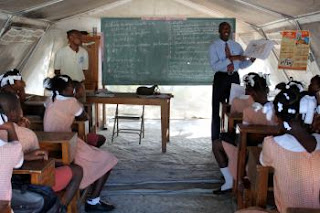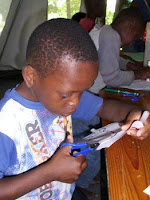"Hola!" shouts a little boy. "Bonjour", says Winni when I get an early coffee. "Good morning" Bettina greets me. But this is not La Paz, Casablanca or Cape Town, all homes to SOS Children’s Villages. This is the SOS Children’s Village Santo in Haiti, where a variety of nationalities living and working here makes up a veritable Tower of Babel.
The island on which Haiti is located is the second largest in the Caribbean and is shared between two nations, Haiti and the Dominican Republic. Because of the colonial history of the island Spanish is spoken in the Dominican Republic and French and Creole spoken in Haiti. I had not expected that I would need Spanish when I came to Haiti so it was a surprise when I realised that several of the SOS co-workers spoke only Spanish, because they come from either the Dominican Republic or Latin America.
 |
| The SOS Children's Village is preparing to take on new tasks and more children - Photo: H. Atkins |
After January’s earthquake there was an influx of volunteers and SOS co-workers. Although many have now returned home there is a small core of foreign co-workers who are either helping with the SOS emergency relief programme or setting up new procedures and systems for an extended village, which also encompasses temporary shelters and 300 extra children.
 |
| SOS co-workers and volunteers from all over the world work at the village in Santo. Pictured: Uli from Germany - Photo: H. Atkins |
There’s Uli, who speaks fluent Spanish, with good English and French as well as her native German; Max from Luxembourg, who speaks French, German, English and what he calls Luxembourgish, and whose Spanish improves by the day; Bettina, an Austrian volunteer who seems to be at home in any language and is learning Creole; and Dionisio from Cape Verde who is fluent in Portuguese, Spanish, French and English. Then there are the other co-workers and volunteers from Nicaragua, El Salvador, Chile and the Dominican Republic. Lucia from Santo Domingo was educated in the US and therefore speaks English brilliantly – she flew over Haiti two days after the earthquake and is still shocked by the memories of what she saw.
 |
| Bettina from Austria and Juan from the Dominican Republic give out emergency rations to families during the recent tropical storm - Photo: H. Atkins |
As for me who normally lives in Nairobi, it has been a challenge resurrecting my French. Sometimes I am amazed that I remember in one nano-second a word I haven’t used for years and other times my mind goes completely blank, or says the first foreign word it can think of, which is usually in Swahili. Such was the case this afternoon when my French was sorely tested by a conversation with the village engineer. He was showing me a solar filtration system donated to the village and installed in July.
‘Sema tena’, I asked him when I hadn’t understood, being the Swahili for ‘Say it again’. Needless to say the poor engineer was as baffled by my Swahili as I was by his French. But that’s beside the point. The system, which filters ground water into drinking water and is powered by the suns rays, of which there are many in Haiti, is brilliant. It just takes a little pressure on the tap for drinking water to emerge, and on release the water flow stops.
 |
| The solar filtration system that produces safe drinking water - Photo: C. Martinelli |
It’s amazing that amidst the apparent chaos of post-earthquake Haiti, including a cholera epidemic, there are such simple and effective solutions to be found for safe drinking water. To put it in the language of my co-workers, it’s fantastic, fantastique, fantastico, phantastisch –take your pick – but for the children of the village, energetic and full of life, it’s simply water.



















































